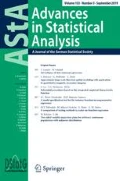Abstract
For the analysis of square contingency tables with ordered categories, Tomizawa (1991) considered the diagonal uniform association symmetry (DUS) model, which has a multiplicative form for cell probabilities and has the structure of uniform association in the tables constructed using two diagonals that are equidistant from the main diagonal. This paper proposes another DUS model which has a similar multiplicative form for cumulative probabilities. The model indicates that the odds that an observation will fall in row category i or below and column category i+k or above, instead of in column category i or below and row category i+k or above, increase (decrease) exponentially as the cutpoint i increases for a fixed k. Examples are given.
Similar content being viewed by others
References
Agresti, A. (1984) Analysis of Ordinal Categorical Data. Wiley, New York
Agresti, A. (1990) Categorical Data Analysis. Wiley, New York
Bishop, Y.M.M., Fienberg, S.E., Holland, P.W. (1975) Discrete Multivariate Analysis: Theory and Practice. The MIT Press, Cambridge, Massachusetts
Goodman, L.A. (1979a) Multiplicative models for square contingency tables with ordered categories. Biometrika 66, 413–418
Goodman, L.A. (1979b) Simple models for the analysis of association in cross-classifications having ordered categories. Journal of the American Statistical Association 74, 537–552
Hashimoto, K. (1999) Class Structure in Modern Japan: Theory, Method and Quantitative Analysis. Toshindo Press, Tokyo
McCullagh, P. (1978) A class of parametric models for the analysis of square contingency tables with ordered categories. Biometrika 65, 413–418
Mullins, E.I., Sites, P. (1984) The origins of contemporary eminent black Americans: A three-generation analysis of social origin. American Sociological Review 49, 672–685
Tomizawa, S. (1991) Diagonal uniform association symmetry model for square contingency tables with ordered categories. The New Zealand Statistician 26, 10–17
Tomizawa, S. (1993) Diagonals-parameter symmetry model for cumulative probabilities in square contingency tables with ordered categories. Biometrics 49, 883–887
Tomizawa, S. (1995) A generalization of the marginal homogeneity model for square contingency tables with ordered categories. Journal of Educational and Behavioral Statistics 20, 349–360
Author information
Authors and Affiliations
Corresponding author
Rights and permissions
About this article
Cite this article
Tomizawa, S., Miyamoto, N. Diagonal uniform association symmetry modelsfor cumulative probabilities in square tables . AStA 91, 269–278 (2007). https://doi.org/10.1007/s10182-007-0034-1
Received:
Accepted:
Published:
Issue Date:
DOI: https://doi.org/10.1007/s10182-007-0034-1



